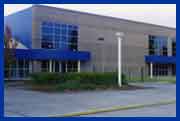The Team
Joshua Brandt jbrandt@darkwing.uoregon.edu
Martha Breed mbreed@darkwing.uoregon.edu
Joshua Cohen jcohen2@darkwing.uoregon.edu
Acknowledgements
Quentin Hogan, Willamalane Pool Maintenance Engineer
Robert Huizenga, Systems West Engineers Inc., Project Engineers
Carl Sherwood AIA, of Robertson Sherwood Architects, Project Architect
The staff of the Willamalane Aquatic Center
Christina Bollo, our Graduate Teaching Fellow
Preliminary Questions
Areas of inquiry: Air Quality, Thermal Mass, Solar Gain.
- What are the levels of chloramine in the air? (What effect does the large HVAC system have on air quality?)
- What causes the ambient temperature differential between the East and West halves of the room?
- Does the solar energy entering through the East and South windows contribute significantly to the building's heat gains?
- Is the building internal-load dominated?
- (What is the role of the water's mass in the heating needs of the building?)
- Is the air temperature driven by heating the air in the HVAC system, or by heating the water?
- Does the concrete slab act as a thermal mass? (i.e. does it contribute passive solar heating?)
- How many air changes per hour (ach) does the HVAC provide?
- Is there a heat exchanger in the HVAC system to recover heat from the air?
- What would a 3D thermal map of the building volume look like (x, y, and z measurements), especially in response to pool temperatures and solar exposure?
- How would covering (insulating) the pools at night affect the heating needs of the air and water, especially in comparison with the needs when the pool is uncovered?
- Is it more efficient to heat the air directly, or only to heat the water directly, and heat the air through conduction?
Raw Data
You can download our raw HOBO data and pool temperature data in comma-space delimited (CSV) / text (TXT) format:
- series1.csv
- series2.csv
- pooltemps.txt
|
|
